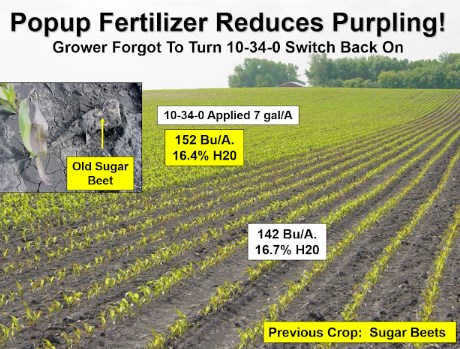By Dan Kaiser
With record precipitation across much of the Midwest in 2019, many fields went unplanted. Fields that were in a prevent plant situation last year may be at risk of fallow syndrome in 2020. When managing fields prone to fallow syndrome, a low rate of “pop up” starter fertilizer is the best management strategy.
What is fallow syndrome?
Fall syndrome is caused by decreased colonization of plant roots by beneficial fungi called vesicular-arbuscular mycorhizae (VAM). VAM act like an extension of the plant’s roots, helping crops such as corn take up phosphorus and zinc. The population of VAM in the soil goes down rapidly in a year with little plant growth, which can negatively impact crop uptake of phosphorus and zinc the following growing season. Fallow syndrome often causes purple coloring of corn plants early in the growing season due to reduced update of phosphorus, which can lead to yield loss.
Which fields and crops are at risk?
Corn following fallow fields has the greatest potential for yield loss from fallow syndrome. Other crops, such as soybean, are at low risk. Corn following some crops and cover crops also requires special management considerations, including corn following sugar beets. Cover crops on prevent plant acres can help reduce the risk of fallow syndrome, but it depends on the species of cover crop. If you seeded oat or small grain crops as a cover last year, the risk of fallow syndrome this spring is very low. Brassica cover crops are not VAM hosts, so they may require management considerations. Research on forage radish, from the brassica family, has not shown negative impacts on the following corn crop, but the potential risk may be higher.
Any plant roots in a field, including weeds, can reduce the risk of fallow syndrome for the following crop. If weeds were present for part of last year’s growing season, there is a reduced chance for fallow syndrome to occur. Fields with extremely high soil P tests, particularly manured fields, are likely at reduced risk. However, research has not identified a specific soil P test above or below which fallow syndrome is more or less likely to occur.
Remember, even if the potential risk for fallow syndrome is high, there is no guarantee that treatment is needed or will be economical.
What should I do about fallow syndrome?
You can’t do much about fallow syndrome once you identify the problem, so it’s best to mitigate risk in advance. If you’re planning on planting corn in a field that was fallow last year, the best course of action is to band phosphorus and chelated zinc directly on the seed as a starter.

Research has not identified an optimal rate, but a normal application of 5 gallons per acre of 10-34-0 could be enough. Some research has shown that upwards of 40 lbs P2O5 banded near the row may be needed to prevent fallow syndrome, however, this is too high of a rate to safely apply directly with the seed. Make sure not to apply too high of a rate due to the risk of root damage to corn (and especially soybean). Banding is important because broadcasting extra phosphorus and zinc has not been shown to be effective for treating fallow syndrome.
Some specialty products are marketed to increase root growth and help with VAM colonization. I have not seen data showing that any of these products work as well as a concentrated band of nutrients near the roots.
Additional information
- The Compendium of Research Reports on Use of Non-Traditional Materials for Crop Production, a searchable database, has more information on specialty fertilizer products. It is managed by Extension soil fertility researchers from several Land Grant Universities in the North Central region. Due to the high number of products sold, not all of those available on the market are currently included.
- Agvise has recommendations for wheat: “The cure for fallow syndrome in wheat, is a high rate of P fertilizer placed near or with the seed regardless of the P soil test level. Placing P fertilizer in a band near the seed is a common practice for wheat growers. They just have to make sure the P rate with the seed is high (be sure to apply a safe rate).”
Source : umn.edu